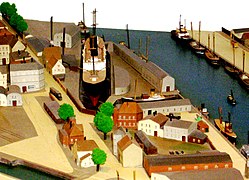Edmund Koester
Edmund Köster (born July 13, 1896 in Marne (Dithmarschen); died July 8, 1943 in Catania ) was a German model maker.
Life
Edmund Köster finished elementary school and his favorite hobby was model making. He graduated from high school in Hamburg in 1914 and was then drafted. He served in the 76th Hanseatic Infantry Regiment and received several awards for his bravery. After the war he completed an apprenticeship as a bookseller. He married in 1922 and two sons were born. After moving to Hamburg-Barmbek in 1927, he set up a small model making workshop in his new apartment in Hamburg-Barmbek and built model farms for the animals made of Elastolin as well as port components and ships as water line models for his sons.
Model builders of ships and port kits
He started with the construction of a model farm for his sons, followed by the model construction of suitable enclosures and also of Christmas cribs for the family and neighbors. When his sons started school, he switched to models for his Märklin gauge 0 railroad, initially on a scale of 1:45 in composite construction made of sheet metal and wood, as well as ship models and the so-called port construction kits.
In 1928 he became self-employed as a model maker, but these large and expensive models were increasingly difficult to sell in the coming global economic crisis. So he started working on the smaller 1: 400 scale models. In addition to individual ships, the port construction kits with ships and port components were increasingly being built. They became known under the name "Hanse Hafenbaukasten". The ships are now made of wood as waterline models. They were designed in a simple way, but showed all the essential properties and characteristics and by restricting to the essentials Köster developed into a master.
From 1932 he built more robust waterline models on a scale of 1: 400 and 1: 250 for the smaller harbor vehicles so that they could serve as "table toys". These became more and more popular as caster models, received the family coat of arms on the underside - the Köstergocke printed on them - and were illustrated and described in initially hand-painted brochures, which were only given for a nominal fee. The wooden models had a relatively large hull and the smaller port vehicles were slightly larger in scale to make them easier to handle. During this time, the first hand-painted brochures and small catalogs were created, which were lent to dealers for a fee.
In 1933 and 1934 the ships were mentioned as "Köster Kleinschiffahrt" in the Deutsche Marine Zeitung and its good reputation spread among shipping companies and travel agencies who liked to exhibit its models. From 1936/37 commissioned work was increasingly added and he made dioramas for museums, for the imperial fish advertising, for the navy and also seafaring schools used the models for nautical lessons. The initial gimmick turned into professional applications and the group of interests also grew through exhibitions.
In the meantime a larger workshop had emerged and up to 22 employees worked in this model manufacture. In addition to supplying the toy trade, shipping companies had Köster reproduce their new steamers true to the original on a scale of 1: 250. So were z. For example, accidents were simulated with the Köster models in the Oberseeamt and the tests in the Hamburg Oberhafenamt were also carried out with Köster models.
Construction of dioramas
Until now only merchant ships have been built, but from 1936 Köster also offered warships and small dioramas were created for shipping companies such as Hamburg Süd and Hapag , and very elaborate for authorities and port companies .
In 1935, the first diorama for the Trade and Industry Museum in Hanover was made largely from commercially available ships. It was destroyed in the war. In 1936, on the occasion of the 40th anniversary, a large diorama of 25 square meters was created, which depicts the fishing port of Wesermünde . It still exists today and is located in the Morgenstern Museum in Bremerhaven. The 75 square meter full port model on a scale of 1: 400 for the Hamburg Authority for Trade, Shipping and Commerce from 1936/1937 burned in the war.
The second large diorama that survived the war shows Hamburg's cityscape from 1644. It shows Hamburg's defense during the Thirty Years' War and the importance of the great ramparts.
gallery
Exhibitions
From December 1996 to February 1997, on the 100th birthday of the Museum für Hamburgische Geschichte, a Köster exhibition was held under the name “The whole shipping in a small way - ship and port models by Edmund Köster” with models by Hans-Jürgen Steffen. It is now in the International Maritime Museum Hamburg . In November 2015, Hans-Jürgen Steffen created a screen presentation for the museum that shows the work of Edmund Köster on deck 9.
literature
- Hans-Jürgen Steffen, Gert Uwe Detlefsen: Köster models: The whole boat trip on a small scale , Verlag Gert Uwe Detlefsen, Bad Segeberg, 1996, ISBN 3-928473-32-8 .
Web links
| personal data | |
|---|---|
| SURNAME | Koster, Edmund |
| BRIEF DESCRIPTION | German model maker |
| DATE OF BIRTH | July 13, 1896 |
| PLACE OF BIRTH | Marne |
| DATE OF DEATH | July 8, 1943 |
| Place of death | Catania |







